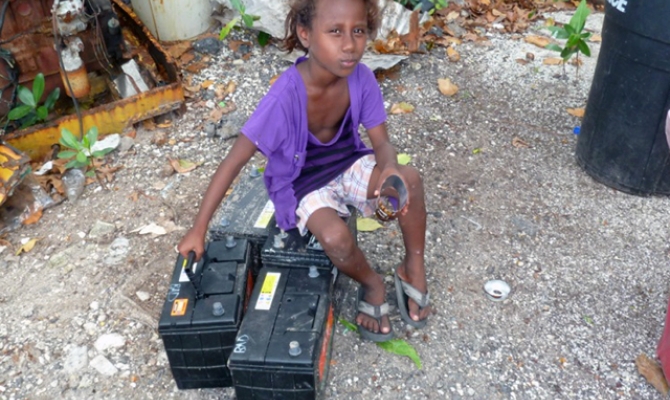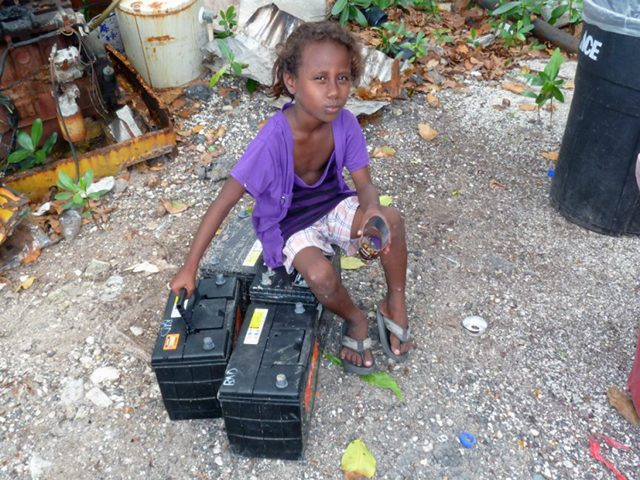
Waste Management and Pollution Control
The very nature of atolls – the fact that they are generally isolated, have a small land area and are low-lying – makes sustainable waste management very challenging. The PacWaste project is tackling these challenges through its pilot integrated atoll solid waste management system in Majuro, Republic of the Marshall Islands.
The lessons learned from this progressive pilot project are intended to inform best-practice atoll solid waste management on other atolls in the Pacific and, indeed, around the world.
PacWaste (Pacific Hazardous Waste) is a €7.85 million, four year project supported by the European Union and implemented by the Secretariat of the Pacific Regional Environment Programme (SPREP) to improve regional hazardous waste management across the Pacific. Integrated atoll waste management is one of four focus areas of PacWaste - the others include asbestos, E-waste, and healthcare waste.
Mr Jesús Laviña, Head of Section for Natural Resources and Infrastructure at the European Union Delegation for the Pacific, Suva explains that PacWaste considered a number of different sites for the pilot project but, ultimately, Majuro was identified as the ideal site for the pilot project:
"The European Union is very pleased to be working in partnership with SPREP and the Government and communities of the Republic of the Marshall Islands on this PacWaste pilot project. This holistic, integrated programme of waste management activities will not just benefit the people and environment of Majuro – is has the potential to revolutionise solid waste management practices in atoll environments around the world."
One of the PacWaste priorities in Majuro is to establish a financially sustainable mechanism for the safe collection and removal of Used Lead Acid Batteries (ULABs). ULABs are one of the most common toxic domestic waste items in the world, and on Majuro Atoll there are thousands of ULABs accumulating each year.

ULABs contain lead and sulphuric acid, both of which are toxic and pose threats to human health and the environment. Because ULABs are considered to be hazardous waste, it is very important that they are stored correctly and that they don't end up in landfills. A single lead-acid battery disposed of incorrectly has the potential to contaminate 25 tonnes of surrounding waste. The good news is that ULABs can be readily re-conditioned or recycled.
PacWaste's Solid Waste Project Officer, Tim Hartley, explains that only about 10% of batteries arriving in the Republic of the Marshall Islands are being removed, so that means that there are a lot more lying around:
"Through PacWaste, we're planning to set up a buyback fund so that we can purchase these ULABs from the general public and then export and sell them to battery recycling companies in other countries. The proceeds of the export sales will be added back into the buyback fund. Our aim with the buyback fund is to achieve a 90% battery removal rate. It's an ambitious goal but it's certainly achievable."
In addition to capitalising the fund, PacWaste will assist in the provision of safe battery handling training and equipment, and develop MOUs between the key stakeholders.
For more information about the integrated atoll waste management programme on Majuro, please visit
www.sprep.org/pacwaste or contact Tim Hartley on [email protected]
The lessons learned from this progressive pilot project are intended to inform best-practice atoll solid waste management on other atolls in the Pacific and, indeed, around the world.
PacWaste (Pacific Hazardous Waste) is a €7.85 million, four year project supported by the European Union and implemented by the Secretariat of the Pacific Regional Environment Programme (SPREP) to improve regional hazardous waste management across the Pacific. Integrated atoll waste management is one of four focus areas of PacWaste - the others include asbestos, E-waste, and healthcare waste.
Mr Jesús Laviña, Head of Section for Natural Resources and Infrastructure at the European Union Delegation for the Pacific, Suva explains that PacWaste considered a number of different sites for the pilot project but, ultimately, Majuro was identified as the ideal site for the pilot project:
"The European Union is very pleased to be working in partnership with SPREP and the Government and communities of the Republic of the Marshall Islands on this PacWaste pilot project. This holistic, integrated programme of waste management activities will not just benefit the people and environment of Majuro – is has the potential to revolutionise solid waste management practices in atoll environments around the world."
One of the PacWaste priorities in Majuro is to establish a financially sustainable mechanism for the safe collection and removal of Used Lead Acid Batteries (ULABs). ULABs are one of the most common toxic domestic waste items in the world, and on Majuro Atoll there are thousands of ULABs accumulating each year.

The lead in Lead Acid Batteries is extremely toxic. Long-term exposure to even small amounts can cause brain and kidney damage, hearing impairment, and learning problems in children. Photo: Alice Leney
ULABs contain lead and sulphuric acid, both of which are toxic and pose threats to human health and the environment. Because ULABs are considered to be hazardous waste, it is very important that they are stored correctly and that they don't end up in landfills. A single lead-acid battery disposed of incorrectly has the potential to contaminate 25 tonnes of surrounding waste. The good news is that ULABs can be readily re-conditioned or recycled.
PacWaste's Solid Waste Project Officer, Tim Hartley, explains that only about 10% of batteries arriving in the Republic of the Marshall Islands are being removed, so that means that there are a lot more lying around:
"Through PacWaste, we're planning to set up a buyback fund so that we can purchase these ULABs from the general public and then export and sell them to battery recycling companies in other countries. The proceeds of the export sales will be added back into the buyback fund. Our aim with the buyback fund is to achieve a 90% battery removal rate. It's an ambitious goal but it's certainly achievable."
In addition to capitalising the fund, PacWaste will assist in the provision of safe battery handling training and equipment, and develop MOUs between the key stakeholders.
For more information about the integrated atoll waste management programme on Majuro, please visit
www.sprep.org/pacwaste or contact Tim Hartley on [email protected]